Articles
“Precision,” “Perfection,” and the Reality of British Scientific Instruments on the Move During the 18th Century
Résumé
On représente souvent les instruments scientifiques du 18e siècle, y compris les chronomètres de précision, comme des objets statiques, à l’état neuf et complets en eux-mêmes dans les descriptions des débuts de l’époque moderne et dans de nombreuses expositions muséales d’aujourd’hui. En réalité, ces instruments se trouvaient presque constamment soumis à des courants physiques. Le mouvement et les conditions environnementales difficiles et changeantes perturbaient souvent leur utilisation et leur entretien, en particulier en mer et lors d’expéditions scientifiques et d’exploration. Ce sont donc les expériences individuelles de réparation et d’adaptation des instruments qui ont grandement contribué à définir la culture de la technologie.
Abstract
Early modern British “scientific” instruments, including precision timekeepers, are often represented as static, pristine, and self-contained in 18th-century depictions and in many modern museum displays. In reality, they were almost constantly in physical flux. Movement and changing and challenging environmental conditions frequently impaired their usage and maintenance, especially at sea and on expeditions of “science” and exploration. As a result, individuals’ experiences with mending and adapting instruments greatly defined the culture of technology and its use as well as later efforts at standardization.
1 In 1769, the astronomer John Bradley finally reached the Lizard peninsula in Cornwall with his men, instruments, and portable tent observatory after a stressful journey. The British Royal Society and Board of Longitude had sent him there to observe the upcoming passage or Transit of Venus across the face of the sun as well as other celestial phenomena, mainly in the hope of settling the latitude and longitude of a coast that was well known to be hazardous to ships. The Transit phenomenon, which had last occurred in 1761 but would not occur again for another 105 years, had prompted European and colonial astronomers to scatter around the globe in the hope of making similar determinations, but also observations accurate enough to aid in the calculation of the distance between the Earth and the Sun. Bradley had not needed to travel as far as many of his Transit counterparts, but the journey and then the conditions on site still posed a danger to the well-being of the observer and his equipment. His letters to the Astronomer Royal, Nevil Maskelyne, at Greenwich reveal great anxiety about reaching the Lizard, erecting the observatory, and then making observations as illness wracked his body and horrible weather hindered his efforts (RGO 14/52: 4-26). On May 19, Bradley recounted how he had checked the poor roads to the peninsula, being unable to land there safely by boat, and then journeyed to the site by wagon although “often very uneasy for fear of the Carriage being overturn’d.” He and his men erected their observatory in weather “so bad [they] ha[d] seen neither Sun or Horizon with any distinctness” (RGO 14/52: 7).
2 After lengthy dealings with the proprietor of the nearby lighthouses in order to secure lodgings (“I find we are got into an Odd part of the Kingdom”), Bradley settled down to wait for the “very dirty” weather to hopefully clear. He noted, “The Fatigue I have met with & the Cold weather has almost laid me up with the Rhumatism” (RGO 14/52: 7-8). On June 4, the astronomer was pleased to record that he had been able to observe most of the Transit despite having had “Rain & in general very Dirty Weather” every day and despite still having his “Rhumatick Complaint.” He believed that the observatory itself would need to be abandoned after the mission because although it answered “its purpose very well … [they] were Obliged to cut it in Pieces very much for the conveniencey of Carriage & some parts by long Standing in the Weather [were] being Rotten” (RGO 14/52: 14-15). On June 18, he hoped to “soon have Orders to return,” writing that, “I do assure you I am so Lame with my Old Rhumatic Complaint that I can scarce crawl about and am afraid of being quite laid up in this Place” (RGO 14/52: 16-17). On July 2, Bradley continued complaining but also described the makeshift arrangement he had rigged up in order to attempt accurate observations in this unwelcoming environment:
3 On July 9, Bradley wrote from Portmsouth, having finally escaped the Lizard, that “in the Seven Weeks there we had but once 24 hours without Rain.” He reported that the spring of the astronomical regulator clock (a long pendulum clock) had been broken and would likely need to be sent to London for repairs, although, somewhat unusually, all of the other equipment had returned undamaged. The keeper of the lighthouses at the Lizard had also been angered by their coming and going without official authorization and by their having painted a Meridian Mark on his house and having left behind the observatory. He exclaimed that “he would never trust to any ones Word again.” Bradley himself was little better off, saying, “My Rhumatick complaint is something better, but I have such a nervous complaint I can scarce write my hand shakes so much I am afraid I shall find the effects of the Lizard Jaunt for some time” (RGO 14/52: 20).
4 This muddy, rheumatic, and rather haphazard episode bears little resemblance to most contemporary representations made to the broader public of 18th-century instruments and their usage. Indeed, the summary of this expedition for the American Philosophical Society reflects few of the problems Bradley experienced, but for the occasional cloud, and concludes that the astronomer was “lucky enough to make a great many useful observations” (Bradley 1769-1771: 114). Early modern “scientific” publications like this, but especially instrument advertising and images, often present these technologies as tidy and self-contained precision tools, practically operating “out of the box.” The reality was of course much messier. Most instrument makers and sellers naturally avoided discussing the complications inherent to using their wares when advertising them in words and images and often cited vaguely defined positive attributes including “perfection” and “exactness.” Many modern museum exhibitions perpetuate this misleading and rather sterile view by presenting orderly lineups of instruments that are disproportionately unmarred by frequent use, mending, or adaptation.1
5 In reality, most early modern instruments were in near-constant physical flux due to movement and to changes in conditions such as temperature and humidity, which sometimes impeded or entirely prevented instrument usage and maintenance. Instrument users also faced additional obstacles from settings that fell short of the ideal—whether urban homes with visual and magnetic interference for astronomical and natural philosophical experiments, or expedition camps plagued by poor weather and terrain. These problems were usually more intense at sea and on expeditions of “science” and exploration—i.e., the further afield one went from more stable and predictable conditions and from the instrument makers in London and large towns.2 The same was true when Britons and other Europeans sought to set up permanent institutions such as observatories in their colonies (Schaffer 2011: 7, 11-12). This resulted in a pervasive “make do and mend” culture enhanced by global networks of communications about instrument procurement, usage, adaptation, and repairs, rather than the smooth and uneventful face presented by many published and visual representations of early modern instruments. This characterized instrument usage by citizens of all of the nations of Europe, since they faced the same sorts of conditions and employed the same general types of technologies. It will be explored here through the experiences of British and British colonial actors, as they increasingly spread out across the globe in search of commercial, “scientific,” and imperial success—and through the products of the unparalleled early modern instrument trade of London, which provisioned much of Europe at this time.
Instruments Before the Advent of “Science”
6 The term “scientific instruments,” although used briefly here and almost ubiquitously in the literature of the history of science and technology, is a significant misnomer. It employs a label that did not exist in the modern sense until well into the 19th century, when the words “science” and “scientist” adopted their current meanings and replaced terms such as “natural” and “experimental philosophy” in learned usage (OED, s.v. “science”; Yeo 2009). It also obscures the production and use of instruments for a wide range of activities that would not be considered scientific today. Instruments were essentially a wide variety of wares that typically involved some combination of sight, mathematics, measurements, or natural phenomena and were not already under the auspices of a specialist craft like that of the clock and watch maker. They were made from diverse materials including paper, wood, shagreen, metal, glass, and ivory, and sometimes with decorative additions such as inlay, and to widely varying degrees of complexity and expense. They were employed in many everyday, professional, and leisure activities, rather than solely being scientific apparatuses.
7 In the English-speaking world, early modern instruments were therefore not classed as “scientific,” but as “optical,” “mathematical,” or “philosophical,” or more narrowly for use in individual subjects such as astronomy and natural philosophy or in “practical” mathematics-oriented pursuits including surveying and navigation (Warner 1990: 83-93; Field 1988: 3-26). Most mathematical instruments such as drawing and geometric tools, sextants, and globes had a graduated scale for performing calculations or for measuring angles and distances. Optical instruments employed lenses or mirrors and included microscopes, telescopes, eyeglasses, and some instrument sights. Philosophical instruments were used in the demonstration or investigation of natural phenomena, including magnetism, electricity, and the attributes of air. They were often employed in exciting public demonstrations, with electrical machines sparking and sizzling or air pumps threatening to suffocate small birds and mammals. Historians of science and technology frequently discuss precision timekeepers as instruments as well, including marine chronometers and the astronomical regulators used in observatories and on astronomical expeditions, even though Georgian Britons often classed them with other timekeepers or as “machines.”3 This disparity highlights the difficulties and potential dangers of trying to apply modern terminology to pre-modern concepts and institutions and of trying to establish impermeable divisions where none truly existed.
8 Even the general categories of “optical,” “mathematical,” and “philosophical” were fluid. Instruments could occupy multiple categories, as when navigational and surveying instruments that were generally classed as “mathematical” had optical sights. Additionally, it became increasingly common as the 18th century progressed for instrument makers and diversified retailers in Britain and its colonies to sell a wide range of instruments rather than specialize in one category, as one can see in Fig. 1. This is a pictorial element that was used in trade cards4 (and perhaps in other forms of advertising such as map and book inserts) by the mathematical instrument and globe-maker Nathaniel Hill (working 1746; died 1768) and likely before him by the mathematical instrument maker and engraver John Coggs (working at least 1718-1740), both of Fleet Street in London. The trade cards, copies of which survive at locations including the Museum of the History of Science at the University of Oxford (J. R. Millburn Bequest) and the Science Museum in London (object no. 1934-0102), depict wares from all three main categories of instrument, which were employed in a wide variety of endeavours. Such diversification was most often accomplished during the 18th century through subcontracting and bartering rather than a single craftsman or workshop having made all three categories of instrument, and occasionally, as the century progressed, by larger workshops like that of George Adams the elder (livery company freedom 1733; died 1772). Instrument making remained mainly a traditional, craftbased enterprise centred upon home workshops that consisted of a master craftsman overseeing the work of varying numbers of apprentices, journeymen, employees, and family members. It was common for instrument makers and general retailers alike to advertise instruments alongside a wide variety of complementary wares, whether it was ship chandler’s wares being sold alongside sextants and telescopes or luxury trinkets and fashions alongside fashionable vision and drawing aids and amusements like the early slide projectors known as magic lanterns (Baker 2010; 2009a: 169-91).5
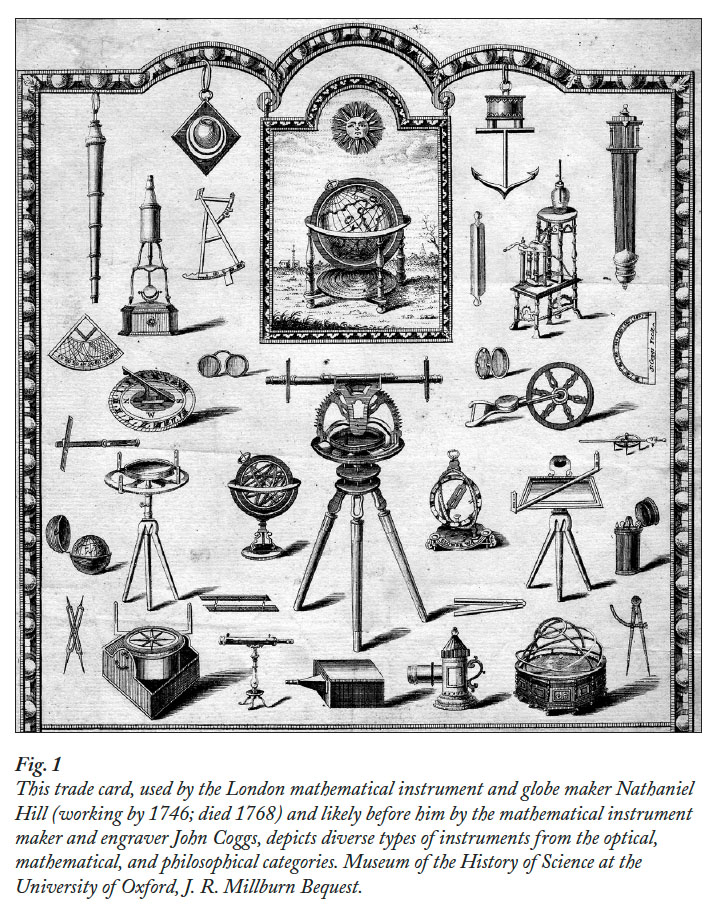 Display large image of Figure 1
Display large image of Figure 19 Most of the specific instruments and instrument makers mentioned in this article hailed from London because the trade in the capital was the single most extensive and the most renowned instrument trade in Britain but also in Europe from the 18th until at least the late 19th century (Morrison-Low 2007: 135-74; Bennett 2002a: 377; Turner 2000: 3; Clifton 1995: vii, xii-xiii; Daumas 1989: 246, 258). This remained true within the English-speaking world even as more provincial manufacturers arose over the course of the 18th century and then especially in the 19th century and as the much smaller American trade expanded (Clifton 1995: xv; Morrison-Low 2007; Bedini 1986). Hundreds of shops in London dispersed their wares across the metropolis and the British provinces, Europe, Russia, and the European colonies including the Americas. They supplied instruments to countless individual and institutional customers at home and abroad including, among others, educators and lecturers, affluent virtuosi and collectors, men and women of fashion, early researchers and observatories, the navy and the military, trading companies, architects, navigators, surveyors, and anyone who needed or wanted vision aids.
Representations Quite Unrepresentative
10 Throughout the 18th century, these products of the British and colonial instrument trades were presented in a relatively unrealistic way, partially as a result of the conventions (and brevity) of most advertising and of art. The pictorial elements of trade cards and related advertising such as map inserts presented instruments as idealized and unproblematic tools, regardless of the differences in artists’ and engravers’ styles and skills. Many cards and inserts featured instruments tidily distributed across the advertisement so that viewers could appreciate the variety and organization of stock, as in Fig. 1 and in a trade card for the optician James Ayscough (livery company freedom 1740; died 1759) of Ludgate Street in London now at the Science Museum in London.6 This presentation style is remarkably similar to the approach that many modern museums and collections still take to displaying instruments, which can mislead viewers as to the original nature of their usage, reliability, and maintenance. This was also the approach eventually adopted in pictorial trade catalogues, which became increasingly common from the late 18th century into the 19th, as subcontracting, larger workshops and, eventually, factories allowed diversified retailers to offer a wide range of stock.
11 Other early modern advertisements featured diverse instruments jumbled around cartouches and Classical allusions, as with a trade card of the diversified instrument maker John Bennet (livery company freedom 1731; died 1770) of West London now at the National Maritime Museum in Greenwich—but these were still artful and tidy constructions of idealized images.7 Some advertisements featured people using instruments but again in an unrealistic manner, as with that of the mathematical instrument maker Richard Rust (livery company freedom 1752; died 1785) of East London, which depicts a nattily attired gentleman sighting through Rust’s new octant with an “artificial horizon,” now at the Science Museum in London (object no. 1934-0111).8 It was the same story with other visual representations of instruments—whether it was depictions in books of mathematical and “scientific” problems to be solved, tiny surveyors at work in the decorative borders of maps, Naval officers brandishing a telescope (or, less frequently, a compass) in portraits as a sign of their profession (as in Fig. 2), or astronomers and surveyors in the panoramic works of expedition artists (as in Fig. 3). Such tidy and idealized views of instruments persisted even as the technical accuracy of some depictions became increasingly realistic over the course of the 18th century, as in Fig. 4.
12 Just as visual representations persistently ignored the untidy reality of instrument usage and maintenance, so too did most texts produced by instrument makers and sellers, from advertising to some of the handwritten and, later, printed instructions included with many instruments (a set of which can be seen in Fig. 5). Makers often kept silent about the likely effects of movement and environmental change upon their products except when responding to specific queries from customers about means of adapting or fixing them. Most instead praised their wares in common but vague positive terms which, while sometimes sharing terminology with later scientific jargon, indicated concepts that were far less concrete and less widely agreed upon than their modern counterparts. In advertisements but also in individual and institutional communications, 18th-century technologies are often referred to as having been “brought to perfection” or as needing to be brought to a greater degree of perfection. This did not indicate absolute perfection or some objective standard but instead a degree of completion and finish which could be interpreted differently by different actors.
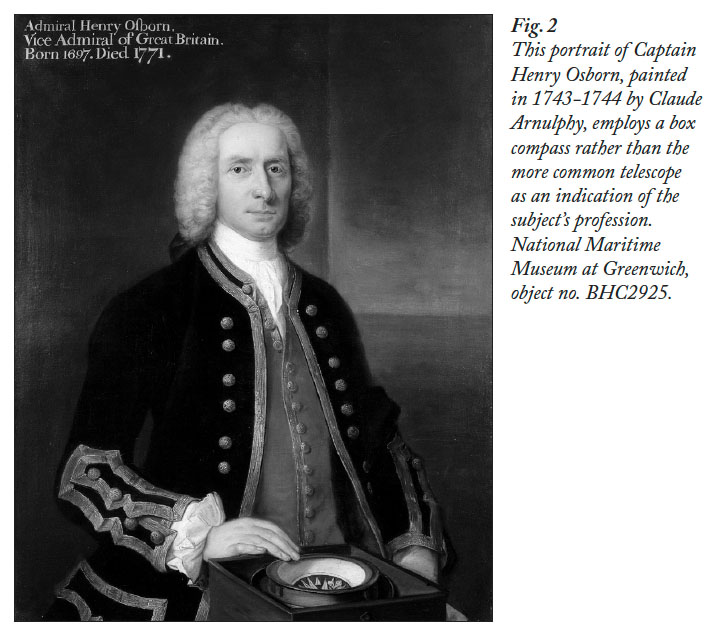 Display large image of Figure 2
Display large image of Figure 213 Similarly, the common early modern term “exactness” bore little relation to the modern scientific concepts of accuracy (closeness of a measurement to the correct value) or precision (degree of refinement of a measurement), which only truly arose during the 19th century after relevant improvements to technologies and shifts in scientific thought and practice with regards to comparing and replicating results (OED, s.v. “accuracy” and “precision”). Some early modern instruments were also touted as being “universal” even though it was unlikely that most would actually perform equally well upon all occasions and in all environments. Another frequent selling point was practicality and the purported ability of people of almost any intellectual and educational means to operate these technologies. The London newspaper the Daily Courant employed a number of these terms when it reported on October 2, 1732, that:
Descriptions of instruments like this, and the visual representations that appeared across a variety of media over the course of the 18th century, presented an image of these technologies as being reliable and self-contained. Anyone who actually employed instruments beyond eyeglasses and basic drawing tools would have understood that their usage and maintenance was in reality quite different. It was an almost constant negotiation between the materials and designs of the products and the challenges of transporting them and of using them under different environmental conditions.
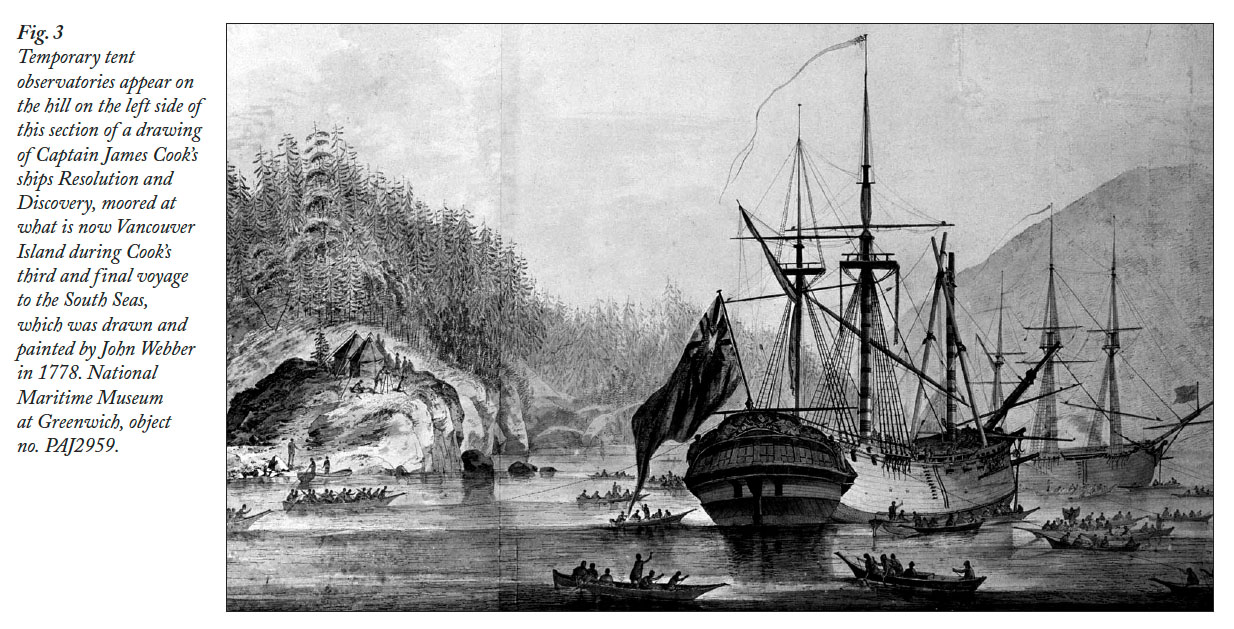 Display large image of Figure 3
Display large image of Figure 3 Display large image of Figure 4
Display large image of Figure 4The Fragility of Instruments on the Move
14 Most 18th-century instruments were far from precise in the modern sense of the word. They were also temperamental, being particularly sensitive to their surroundings. Exposure to movement and to changing environmental conditions often shook parts out of alignment or broke them and made materials such as wood and metal shrink or expand, sometimes at different rates. Of course, this was a problem for instruments that essentially remained in situ or did not travel far as well as for those employed or transported on the roiling seas and in the wilds of distant lands. Individuals and institutions were frequently plagued by the misalignments caused by vibrations, limited transport, and the expansions and contractions caused by changing temperatures and humidity levels. They were also hindered by other less-than-ideal characteristics of their surroundings, such as the horizon being obscured during astronomical sightings or local magnetic conditions interfering with natural philosophical experiments. Nicky Reeves has detailed the battles fought by Nevil Maskelyne (1732-1811) against such physical and environmental impediments to his use of the zenith sector (Fig. 4) and other large astronomical instruments at the Royal Observatory at Greenwich (Reeves 2009: 127-39). Individual enthusiasts of astronomy and natural philosophy faced similar problems despite typically working with less expensive technologies and attempting to achieve less ambitious results. For example, the clock and instrument maker and part-time astronomer and natural philosopher George Graham (livery company freedom 1695; died 1751) attempted observations and experiments at his home and shop in Fleet Street in London but was sometimes stymied by the surrounding conditions. At one point, Graham conducted experiments on the behaviour of a magnetic needle (as in a compass):
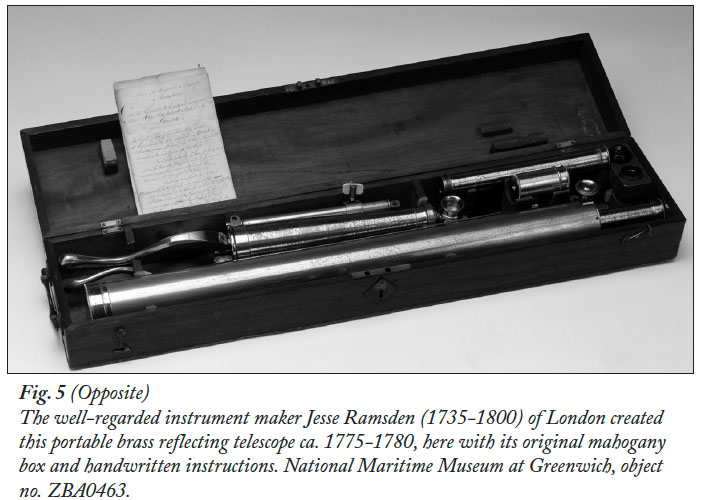 Display large image of Figure 5
Display large image of Figure 5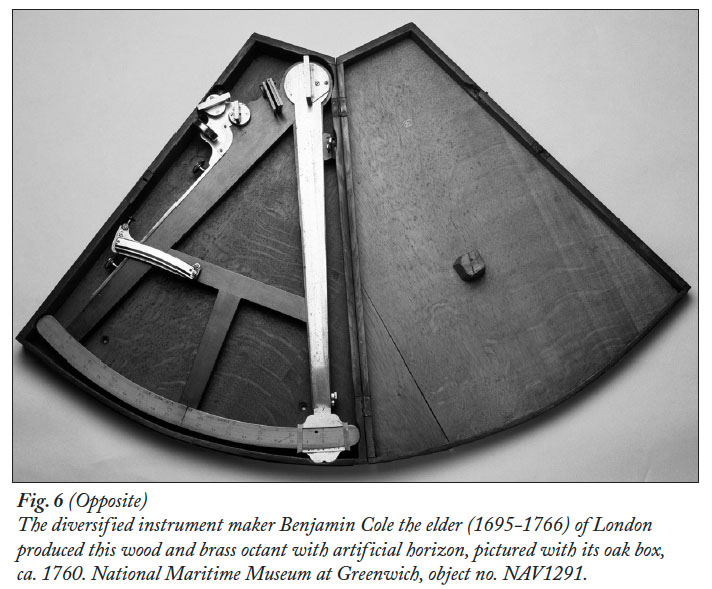 Display large image of Figure 6
Display large image of Figure 6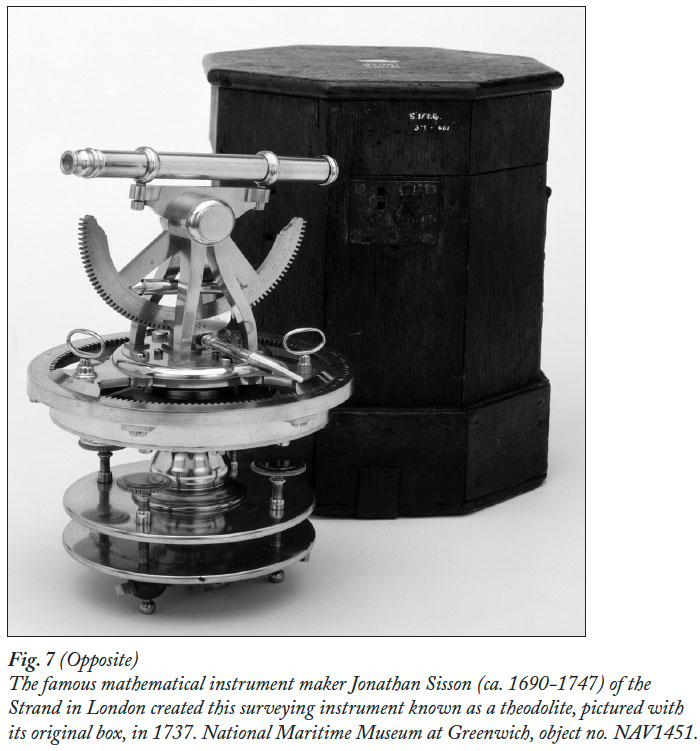 Display large image of Figure 7
Display large image of Figure 715 Such complications were even more of an issue for instruments that travelled over and were used at sea and in distant lands because of the challenging conditions and the distance from suitable repairers. The technology intended for use aboard ship faced the jarring motions of the waves and sometimes dramatic changes in temperature and humidity. This impeded the making of astronomical and natural philosophical observations, but also the use of marine timekeepers and navigational instruments and efforts to reliably “find the longitude” at sea. Researchers and observers on expeditions faced having their equipment disordered or broken en routeand often faced arduous conditions once they reached their destinations. These actors were often far from any specialist instrument maker, let alone the original manufacturers of their equipment.
16 The challenge of transporting instruments, whether across land or sea, was one that affected both expeditions and the large-scale export of instruments from London and other large British cities to the provinces and overseas.10 This export included individual commissions from renowned instrument makers such as the telescope mirror maker James Short (1710-1768) and the precision instrument maker John Bird (1709-1776), both of London, and the wholesale transport of mostly small instruments such as vision aids and pocket sets of mathematical and drawing tools. The successful spectacle maker and diversified retailer George Willdey (livery company freedom 1702; died 1737) near St. Paul’s Churchyard in London pumped more than 17,000 small instruments, vision aids, and instrument components into the British provinces and Europe over a period of fifteen years (Baker 2010: 254-321). Willdey’s wholesale customers were located in provincial towns, including Windsor, Plymouth, and Colchester, and overseas, including in Portugal and Spain and possibly in what would later be known as Italy, Germany, and the Netherlands. While there are not enough surviving instrument shop accounts to indicate whether this sort of scale was common among 18th-century instrument sellers, many sources reveal the advertising and sale of British instruments to other nations and their colonies at both the wholesale and commissioned levels throughout this period.
17 One rich source for descriptions of the difficulties of instrument transport is the letters of the American author, statesman, and natural philosopher Benjamin Franklin (1706-1790). Franklin was engaged with the London instrument trade from at least the 1730s to the 1780s to obtain his own instruments, instrument repairs, and adaptations and to obtain the same for his global networks of friends and correspondents and for educational institutions and societies. For example, in 1755 Franklin asked Peter Collinson (1694-1768) to obtain one of the new air pumps invented by the mathematical instrument maker and engineer John Smeaton (1724-1792) of Holborn for the statesman’s Philadelphia Academy. Collinson was a British botanist and Fellow of the Royal Society in London who had strong ties to America through his Quaker family’s cloth trading business.
18 On November 22, 1756, the American reported receiving the pump and apparatus but said, “There is some Breakage, of which shall send an Account per next Ship, to have the Glasses renew’d” (Franklin 1756b). He elaborated upon the missing and broken components in an ensuing letter of December 19:
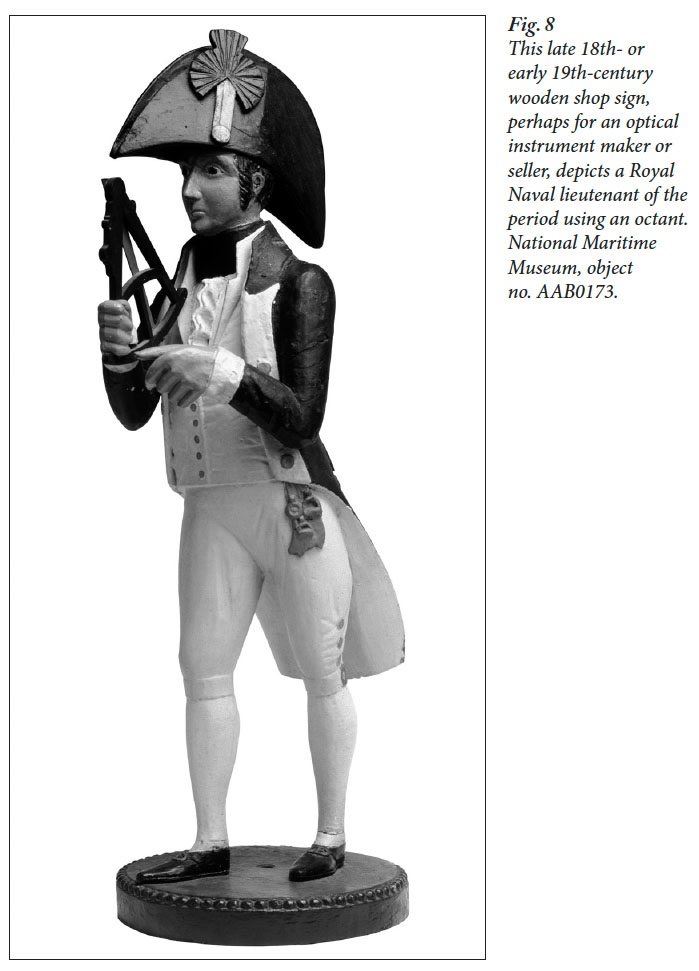 Display large image of Figure 8
Display large image of Figure 819 Franklin’s correspondence further reflects the damage that was sometimes done to instrumentpacking crates and special-made cases—some of which can be seen in Fig. 5-7—in transit. In 1757, Franklin arranged for the Speaker of the Pennsylvania Assembly, Isaac Norris (17011766), to have a 24-foot focal length telescope made in London. Norris wrote to Franklin on January 15, 1759, that while the ship carrying his new telescope had made it into port before the worst winter weather, “The Telescope [box] came in damp so that it swelled and [he] could not open it when [he] was in Town” (Norris 1759). Franklin mentioned similar problems in a letter he wrote from France on October 18, 1783, to his friend the diversified instrument maker Edward Nairne (1726-1806) near the Royal Exchange in London. The statesman said that he had often observed mahogany instrument boxes shrinking and expanding in the climates of different nations. Georgian Britons had to worry about instrument cases’ sealing shut or harming their contents during physical fluctuations in addition to instruments being directly broken or disordered.
The Usage of Instruments on the Move
20 Beyond such common problems with transporting instruments for sale or use abroad, there were also severe obstacles to their being used while aboard ships, whether in navigation or during travellers’ experiments. Eighteenth-century navigators mostly employed combinations of compasses, basic traditional tools like lead-lines, and instruments for astronomical observations such as the quadrant, octant (invented ca.1730; see Fig. 6 and 8), and sextant (invented in 1757)—and, by the end of the century, marine timekeepers were used in tandem with the other technologies. Marine chronometers, as these timekeepers would come to be known, would not actually come into near-universal use on European ships and be seen as reliable in and of themselves until the 19th century (Howse 1980: 72). In addition to potential warping and breakage under maritime conditions, sea travel posed such a problem for the use of astronomical instruments because of the motion of the vessels and the frequently poor visibility. Rolling and unpredictable movement and changing weather sometimes made it very difficult to use instruments such as a telescope or sextant to observe the distance between celestial bodies and the horizon or between different celestial bodies. Timekeepers faced the same problems of metals expanding and contracting at different rates, as did many other instruments, and of the movement of the ship interfering with the movement of their workings—especially since early 18th-century precision timekeepers were originally pendulum clocks.11
21 Some of the sources that best reveal obstacles to the use of instruments and timekeepers, on expeditions and aboard ship, are records of voyages like those completed by the famous Captain James Cook (1728-1779). Cook’s final voyages combined efforts of exploration, “science,” and the search for the longitude at sea. On his second voyage through Antarctic and Pacific waters from 1772 to 1775, the astronomer William Bayly (baptized 1738; died 1810) travelled on the ship Adventure while William Wales (baptized 1734; died 1798) travelled on the Resolution, both making observations including for the lunar-distance method of finding the longitude and conducting experiments on the ships. They did the same ashore for geographical, astronomical, and natural philosophical purposes whenever a long enough landfall was made. Their temporary astronomical observatories probably looked similar to those depicted in Fig. 3. Wales later wrote that these tent buildings were invented by Bayly and that the design was “undoubtedly one of the most convenient portable Observatories that had yet been made,” with hinges allowing “the roof to open and close like an umbrella” (Wales 1777: vii). Bayly and Wales also carried marine timekeepers made by John Arnold (1735/6-1799) and Larcum Kendall (1719-1790), for testing and for comparison to each other and periodically to astronomical regulator clocks. The Board of Longitude was interested, in the wake of their dealings with the famous clockmaker John Harrison (baptized 1693; died 1776; see Fig. 9 and 10), in developing chronometer designs that were reliable but also inexpensive and replicable enough to be rolled out across the Naval and mercantile fleets.
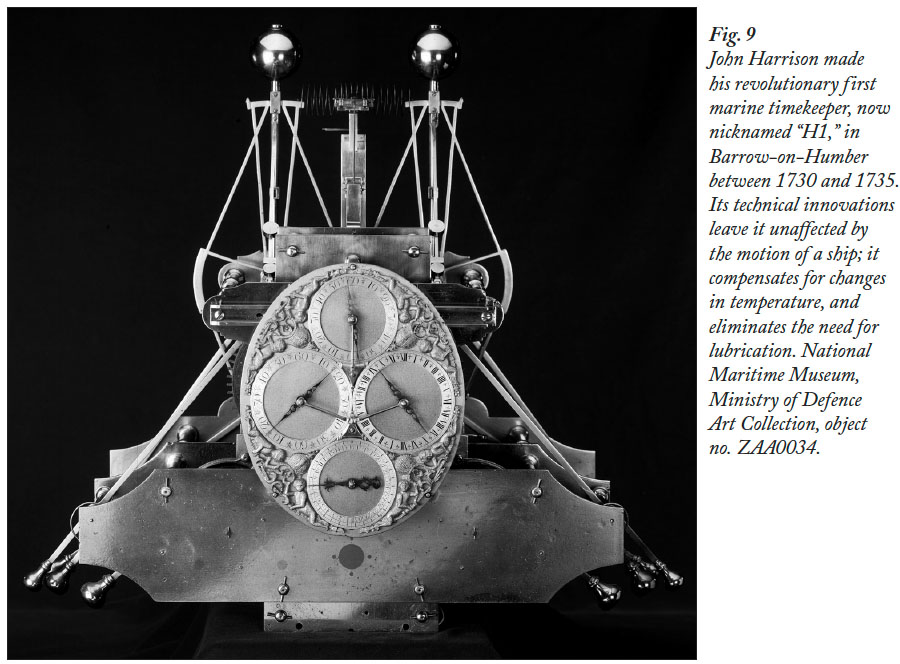 Display large image of Figure 9
Display large image of Figure 922 William Bayly’s log book from 1772 to 1774, now in the Royal Greenwich Observatory (RGO) collection at the University of Cambridge, paints a vivid picture of his struggles to continue making astronomical and natural philosophical observations and to maintain the marine timekeepers under arduous conditions. In the Antarctic waters, fantastical sights of icebergs, whales, dolphins, penguins, and the Aurora Australis alternated with horrendous weather, including violent storms and snow, waves breaking over the decks, and poor visibility. Bayly noted on September 19, 1772, “During the 24 hours had strong gales & squally with a hollow trembling Sea. Which made the Ship rowl greatly” (RGO 14/56: 19). The weather and visibility were frequently so poor that even when the Adventure and Resolution were accompanying each other, they were not able to make contact visually or by firing cannons. Bayly persisted in conducting experiments whenever possible, even during these episodes, as he recorded on November 29:
23 Dramatic changes in temperature and humidity ultimately lost Bayly his thermometer on May 28, 1774, when “the bottom of the case of the Thermometer dropt out it being unglued by the change of weather, by which means the Thermometer fell down & broke” (RGO 14/56: 134). There were also problems with the timekeepers from early on in the voyage, whether due to the conditions, the designs, or human error. The astronomer noted on October 5, 1772 that watch no. 2 had “lost” an unusually high amount of time as compared to watch no. 1: “I frequently saw the second hand stand still 2 or 3 seconds & then go on again but from what cause I know not” (RGO 14/56: 23). Other problems with the timekeepers resulted from mishaps with their cases, which were locked with multiple keys in order to ensure the fairness of the trials through the presence of multiple key holders and thus witnesses. Bayly recorded in his observations book on December 23, 1772:
In May 1773, a key broke in the lock, requiring an additional breakage and repair, and a month later the astronomer had to break into the box to wind the watch because one of the key holders had left the ship (RGO 14/57: 5).
24 Bayly’s observations book provides details about the complexities of setting up the tent observatories, larger astronomical instruments, and pendulum regulator clocks on land as well. These emphasize the complications of using and maintaining instruments in foreign lands but also the patience and ingenuity that their users often displayed in overcoming these obstacles as best they could. They clearly knew better than to expect all of their technologies to remain whole and unscathed or to run smoothly. In July 1772, Bayly creatively screwed his astronomical regulator clock to the end of a heavy bookcase in the Consul’s House in Funchal on Madeira because “the book-case stood on a floor that was paved with Bricks & it was full of Books which rendered it very steady” (RGO 14/57: 3). In October and November of that year, he had to overcome a number of irritations when he set up his instruments and observatories at Table Bay at the Cape of Good Hope, where Mason and Dixon had made their observations of the Transit of Venus in 1761. He first filled the stand of his astronomical quadrant with water to weigh it down but then resorted to sand after the water began leaking. On November 4, a strong wind “brought great Quantities of sand from the Table mountains which greatly Affected the Instruments by Covering them with sand & shaking them & it was with difficulty [they] secured the tents from oversetting” (RGO 14/57: 12). A few days later, a heat wave struck and his “Clock C lifted qui[c]k of[f] the Iron it rested on I imagine ... by the Expansion of the Iron bar it was screwd to. [He] made it steady by applying wood wedges” (RGO 14/57: 12).
25 Such irritations continued into 1773, with Bayly first losing a thermometer that he was lowering into the sea to measure the temperature of the waters on March 28: “I proposed to have let it down again : but by accident it struck again the side of the Boat, & upon examination I found the small Tube broke off just above the Ball, with the shake it received from the Stroke” (RGO 14/57: 25). When they reached Charlotte Sound in New Zealand the following month, the astronomer had to cut stone steps into an uninhabited island in order to make his observations:
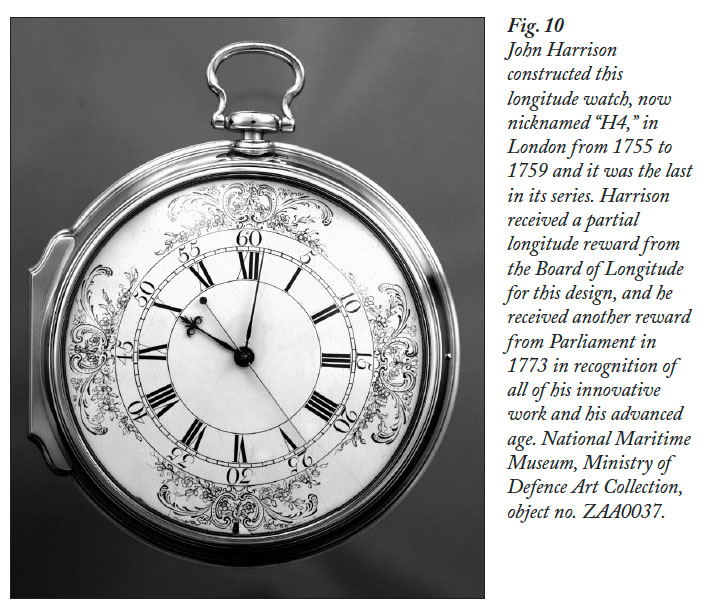 Display large image of Figure 10
Display large image of Figure 1026 On the Resolution, Bayly’s counterpart William Wales was having similar experiences, which he recorded in log, observation, and journal books from 1772 to 1775 (RGO 14/58, 14/59a, 14/59b). One thermometer broke before the voyage began; Wales had to craft a new piece to replace that which had broken on an instrument, and his clock stopped working in March 1775 after he incorrectly replaced its broken glass (RGO 14/58: 2; RGO 14/59: 8 & 22). The astronomer’s journal reveals that he had to force the locks on the box for Arnold’s chronometer box in May 1773, much as Bayly had needed to do (RGO 14/59: 7). Additionally, said chronometer had stopped working at the Cape of Good Hope on October 27, 1772 when he was transferring both watches by skiff back to the ship:
27 Messy details like these seldom made it into official reports on the outcomes of Cook’s expeditions, as was typical of the conduct and publications of 18th-century “science” and its instruments. Wales did note in his published account that the clocks exhibited “some very extraordinary irregularities” in their rates of going at different locations and that the beat of the “assistant clock” had been made quite loud because that would be “particularly useful to us, whose Observatories stood generally on the seashore, where the roaring of the surf seldom permitted us to hear the Astronomical Clock all the time it was going” (Wales 1777: xiii, xviii-xix). Such details of expeditions and, more particularly, of individual experiences of these, vividly emphasize that the use of instruments in 18th-century activities such as navigation, astronomy, and natural philosophy was sometimes a challenging and problematic affair.
Looking Beneath the Surface
28 In some ways, the common instrument descriptors cited at the beginning of this article, including “perfect” and “exact,” are red herrings. They imply to a modern audience over-exaggeration and perhaps an image of early modern researchers and observers stumbling toward the modern definitions of those concepts. In reality, the vague meanings of those early modern terms, and the degree to which they were defined by individual opinion and experience, accurately reflect the nature of the technology and technology usage of that time. As is discussed by authors in volumes including The Values of Precisionand Instruments, Travel and Science, it was really only from the later 18th century on that developments in technology (including the spread of engines for precision-dividing instrument scales) and developments in “science” (such as the increased valuing of experiments being replicable) initiated the gradual development of modern precision (Wise 1997; Bourguet, Licoppe, and Sibum 2002).13 Most 18th-century actors did not envision one absolute definition of perfection or precision when they invoked that terminology, as the means and ideas to make them universal constants did not exist.
29 The visual and advertising languages of instruments, and the scope of some “scientific” publications, appear suspiciously glossy and uncomplicated when it comes to representing 18th-century technology and its use. However, important elements of the messy truth were in fact interwoven throughout instrumental and “scientific” culture. It was clearly recognized within technology and “science” throughout the early modern period that maritime and foreign climes were particularly challenging to human endeavours. This recognition is reflected in discussions of maritime issues such as the longitude problem, designs offered for use specifically at sea, aids invented to facilitate the use of instruments in that environment, and increasing attempts made to reconstruct the conditions of challenging environs during the trialling and testing of mobile technologies. For instance, there were “sea telescopes,” including designs made with long wooden barrels for additional strength and stability and telescopes advertised as being of particular interest to the Navy. Some inventors suggested adaptations for making any telescope more stable for use at sea, as is depicted in a slightly later drawing in Fig. 11. Makers invented other accoutrements to overcome the obstacles faced at sea or on an expedition as well. “Artificial horizons” were often added to astronomical and navigational instruments by the later decades of the century in order to compensate for the real horizon having been obscured by poor weather or darkness, or features on land.
30 Beyond such new instruments and attachments, the early modern period saw many attempts being made at mitigating the environmental conditions faced by instrument users rather than directly altering instruments. Some of the most unusual of these were perhaps the “marine chairs” or “marine observatories,” many of which were proposed to the Board of Longitude from at least the 1750s on. They tended to involve actual chairs or platforms for astronomical viewers, which were steadied by vast gimbals or pendulums either aboard ship, like the early chair of the Irishman Christopher Irwin, or floating almost freely in the water like the slightly later version depicted in Fig. 12. Recognition of the importance of environmental conditions to successful instrument usage led actors and institutions to increasingly attempt to introduce real or equivalent conditions to instrument trials and regulation as well. One of the clearest cases of this is the aforementioned search for the longitude, in which it was vital that any method of estimating longitude at sea (or any other navigational improvement funded or rewarded by the Board of Longitude) be able to perform acceptably in diverse maritime conditions. As Jim Bennett and other authors have described, the Board struggled during the 18th century from the 1730s on to determine the best combination of sea trials, land-based trials, and trial locations to confirm whether John Harrison’s marine timekeepers and later those of other chronometer makers would prove accurate and reliable enough for widespread maritime use (Bennett 2002b: 75-95).
31 Yet perhaps the most striking attribute of the early modern culture of instruments is the degree to which networks of correspondents, friends, and agents, were vital to obtaining, communicating, understanding, and successfully using these implements. Such networks were a common attribute of early modern society and institutions at large.However, the high degree to which the knowledge needed to successfully operate and maintain instruments remained concentrated in these channels throughout the 18th century diverges from some common narratives about the development of technology and of “scientific” practice by the later period. The importance of interpersonal communication of personal knowledge and experience persisted even as, during the later decades, influential actors such as Nevil Maskelyne and institutions such as the Admiralty began to publish increasingly detailed standardized instructions for astronomers sent out on expeditions and attempted to standardize precision equipment such as chronometers. As the century progressed, testimonials from relevant and respected individuals about new and improved technologies were joined as acceptable proof but never superseded by institutional forms of approval, patents and publications, realistic and authoritative diagrams, and comparisons with the abilities and behaviour of similar implements.
 Display large image of Figure 11
Display large image of Figure 1132 Instrument advertisements and images and many “scientific” publications may have presented early modern instruments as authoritative and self-contained tools, much as do many modern museum exhibitions. However, just below the surface of this genteel facade, individuals and institutions were constantly communicating with each other about the nature of, and solutions to, the myriad obstacles produced by the limitations of 18th-century technology and by variable environments. This is an aspect of the early modern history of technology which has yet to be incorporated into most modern museum presentations of instruments and which ought to be incorporated more often into academic discussions of the history of science and technology. It was a central influence upon the production and use of instruments, the conduct and communication of related activities including research and observation, and efforts toward the standardization of practice and technology around the globe.